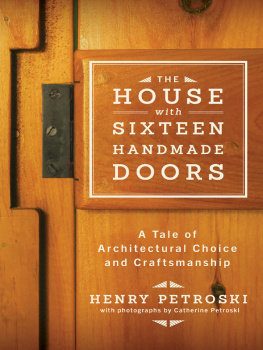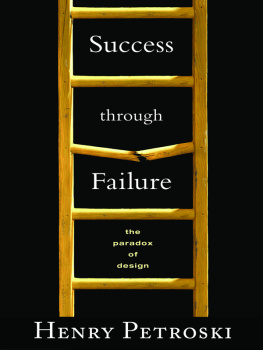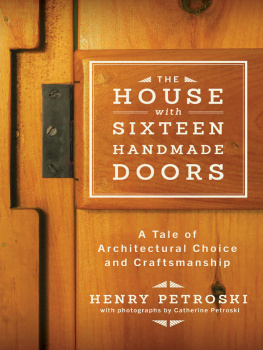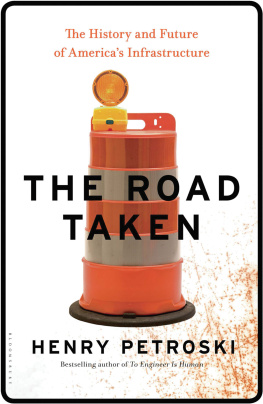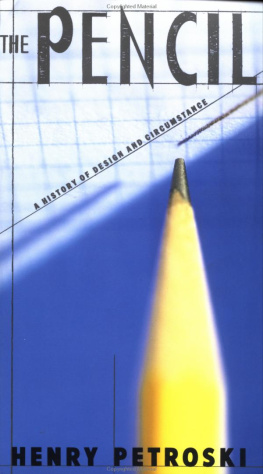Henry Petroski - The Pencil: A History of Design and Circumstance
Here you can read online Henry Petroski - The Pencil: A History of Design and Circumstance full text of the book (entire story) in english for free. Download pdf and epub, get meaning, cover and reviews about this ebook. year: 2010, publisher: Alfred A. Knopf, genre: Art. Description of the work, (preface) as well as reviews are available. Best literature library LitArk.com created for fans of good reading and offers a wide selection of genres:
Romance novel
Science fiction
Adventure
Detective
Science
History
Home and family
Prose
Art
Politics
Computer
Non-fiction
Religion
Business
Children
Humor
Choose a favorite category and find really read worthwhile books. Enjoy immersion in the world of imagination, feel the emotions of the characters or learn something new for yourself, make an fascinating discovery.

- Book:The Pencil: A History of Design and Circumstance
- Author:
- Publisher:Alfred A. Knopf
- Genre:
- Year:2010
- Rating:3 / 5
- Favourites:Add to favourites
- Your mark:
- 60
- 1
- 2
- 3
- 4
- 5
The Pencil: A History of Design and Circumstance: summary, description and annotation
We offer to read an annotation, description, summary or preface (depends on what the author of the book "The Pencil: A History of Design and Circumstance" wrote himself). If you haven't found the necessary information about the book — write in the comments, we will try to find it.
The Pencil: A History of Design and Circumstance — read online for free the complete book (whole text) full work
Below is the text of the book, divided by pages. System saving the place of the last page read, allows you to conveniently read the book "The Pencil: A History of Design and Circumstance" online for free, without having to search again every time where you left off. Put a bookmark, and you can go to the page where you finished reading at any time.
Font size:
Interval:
Bookmark:
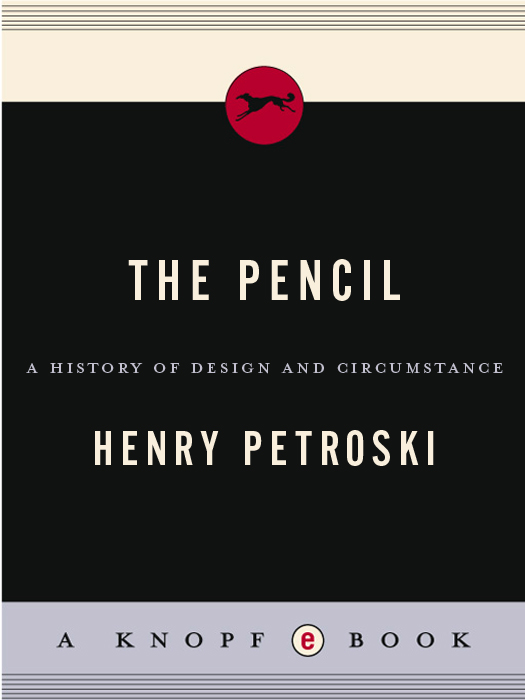
ALSO BY HENRY PETROSKI
Small Things Considered: Why There Is No Perfect Design
Paperboy: Confessions of a Future Engineer
The Book on the Bookshelf
Remaking the World: Adventures in Engineering
Invention by Design:
How Engineers Get From Thought to Thing
Engineers of Dreams:
Great Bridge Builders and the Spanning of America
Design Paradigms:
Case Histories of Error and Judgment in Engineering
The Evolution of Useful Things
To Engineer Is Human:
The Role of Failure in Successful Design
Beyond Engineering:
Essays and Other Attempts to Figure Without Equations
Pushing the Limits:
New Adventures in Engineering
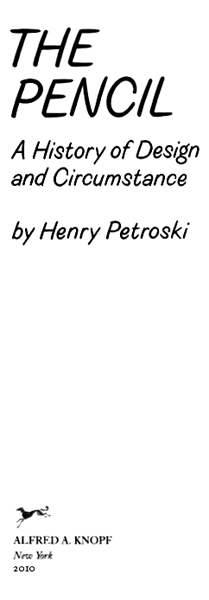
THIS IS A BORZOI BOOK
PUBLISHED BY ALFRED A. KNOPF, INC .
Copyright 1989 by Henry Petroski
All rights reserved under International and Pan-American Copyright Conventions. Published in the United States by Alfred A. Knopf, Inc., New York, and simultaneously in Canada by Random House of Canada Limited, Toronto. Distributed by Random House, Inc., New York.
Portions of this book were originally published in Across the Board and in American Heritage of Invention & Technology.
Grateful acknowledgment is made to Koh-I-Noor Rapidograph, Inc., for permission to reprint excerpts from How the Pencil Is Made from The Pencil : Its History, Manufacture, and Use by The Koh-I-Noor Pencil Company. Reprinted courtesy of Koh-I-Noor Rapidograph, Inc.
Correspondence between Ralph Waldo Emerson and Caroline Sturgis quoted by permission of the Ralph Waldo Emerson Memorial Association and of the Houghton Library.
Library of Congress Cataloging-in-Publication Data
Petroski, Henry.
The pencil: a history of design and circumstance/by Henry Petroski. 1st ed.
p. cm.
eISBN: 978-0-307-77243-5
1. PencilsHistory. I. Title.
TS1268.P47 1989
674.88dc20 89-45362
v3.1
To Karen
Appendix A
From How the Pencil Is Made
A ll made objects owe their very existence to some kind of engineering, which is essential for civilization. Even the commonest and oldest of artifacts are no less the products of primitive engineering than the artifacts of high technology are the products of modern scientific engineering. But while the practice of engineering has certainly evolved since ancient times, it has also maintained a family resemblance to its ancestors. Although engineers today tend to be more formally mathematical and scientific than their counterparts just a century ago, there are still essential elements of engineering that all ages have in common. A modern engineer and an ancient, even if called an architect or master builder or master craftsman, would find plenty to talk about, and each would be able to learn something from the other.
This timelessness derives from a constant underlying quality inherent in all engineering, a quality that is independent of formal education. The existence of this commonsense aspect of it explains why and how so much ancient and even not so ancient engineering was done by individuals who worried about neither what they themselves nor what they were doing was called. Indeed, such seemingly unlikely persons as the political philosopher Thomas Paine and the philosophical writer Henry David Thoreau effectively acted as if they were engineers and made real contributions to the technology of their times. For this same reason, I believe that anyone today is capable of comprehending the essence of, if not of contributing to, even the latest high technology. Behind all the jargon, mathematics, science, and professionalism of engineering lies a method as accessible and as pervasive as the air we breathe. Certainly business executives with no formal engineering training daily assume this to be the case in making decisions with major technological implications. But that is not to say that professional engineers are dispensable, for it is one thing to understand their method and another to be able to apply it to the details of an increasingly complex and international technological environment and then condense the results in an executive summary.
Because all engineering, past and present, has a common feature to its fabric, the method of engineers and of engineering is embodied in everything ever made and thus is accessible through any single artifact. I believe that a person who is attracted to bridges, for example, can learn more about the method of all engineeringincluding such seemingly diverse branches as chemical, electrical, mechanical, and nuclear engineeringfrom a focused study of bridges alone than from a diffuse and cursory survey of all the past and latest wonders of the made world. Yet a focused study need not be overly technical. It need only place the artifact in a proper social, cultural, political, and technological context in order to allow the essence of engineering to be distilled by the receptive mind. For it is attention to all aspects of the long evolutionary process by which such a thing as a rotting log across a stream becomes a corrosion-free suspension bridge across a strait that we discover the essence of engineering and its role in civilization. Just as there is no artifact that is without engineering, so there is no engineering that is free of the rest of society.
In this book I have chosen to approach engineering through the history and symbolism of the common pencil. This ubiquitous and deceptively simple object is something we can all hold in our hands, experiment with, and wonder about. The pencil, like engineering itself, is so familiar as to be a virtually invisible part of our general culture and experience, and it is so common as to be taken up and given away with barely a thought. Although the pencil has been indispensable, or perhaps because of that, its function is beyond comment and directions for its use are unwritten. We all know from childhood what a pencil is and is for, but where did the pencil come from and how is it made? Are todays pencils the same as they were two hundred years ago? Are our pencils as good as we can make them? Are American pencils better than Russian or Japanese pencils?
To reflect on the pencil is to reflect on engineering; a study of the pencil is a study of engineering. And the inescapable conclusion after such reflection and study is that the history of engineering in a political, social, and cultural context, rather than being just a collection of interesting old stories about pencils or bridges or machines, is very relevant to and instructive for engineering and commerce today. The important roles that international conflict, trade, and competition play in the history of the pencil provide lessons for such modern international industries as petroleum, automobiles, steel, and nuclear power. This is so because the engineering and the marketing of the pencil are as inextricably intertwined as they are for any artifact of civilization.
A book is also an artifact, of course, and its author incurs many debts throughout the course of its production. My acknowledgments to works, institutions, and people appear at the end of this book, but some support and encouragement have been too invaluable not to be repeated here. I was able to concentrate on this project through the support of a sabbatical from Duke University and fellowships from the National Endowment for the Humanities and the National Humanities Center. Of the many librarians who have helped me, Eric Smith, of Dukes Vesic Engineering Library, is without peer. My brother, William Petroski, was a constant source of unique information and artifacts. But it was the immeasurable patience and encouragement of my son, Stephen, my daughter, Karen, and most of all my wife, Catherine Petroski, that in the end made this book possible.
Font size:
Interval:
Bookmark:
Similar books «The Pencil: A History of Design and Circumstance»
Look at similar books to The Pencil: A History of Design and Circumstance. We have selected literature similar in name and meaning in the hope of providing readers with more options to find new, interesting, not yet read works.
Discussion, reviews of the book The Pencil: A History of Design and Circumstance and just readers' own opinions. Leave your comments, write what you think about the work, its meaning or the main characters. Specify what exactly you liked and what you didn't like, and why you think so.


